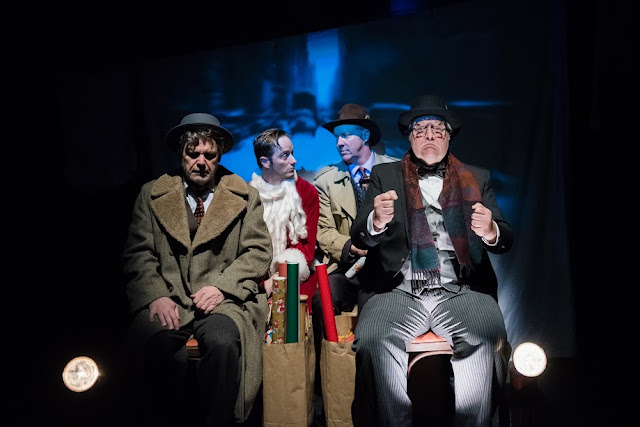“Wise
Guys and Dolls”

 Unlike the thoroughfares of, let us say, Paris, the
streets of Manhattan, with a few exceptions, are not known for memorializing
famous local literati or theatrical celebrities. When they are, they’re likely
to be like patronizing shoulder slaps, little more than brief sections of
longer roadways.
Unlike the thoroughfares of, let us say, Paris, the
streets of Manhattan, with a few exceptions, are not known for memorializing
famous local literati or theatrical celebrities. When they are, they’re likely
to be like patronizing shoulder slaps, little more than brief sections of
longer roadways.
Take, for example, Runyon’s Way, which covers the
block of W. 45th Street between Eighth and Ninth Avenues. For those
not in the know, which would be anyone who’s never heard of Guys and Dolls, this piece of theatre
district real estate is named for Damon Runyon (1880-1946), a popular
Manhattan-born (Manhattan, Kansas, that is!) Hearst journalist and short story writer.
 |
| Jeffrey C. Hatcher, Ron McClary. Photo: Marielle Solan. |
From all his writings, he’ll forever be best
remembered for his colorful tales of New York’s pre-World War II demimonde of
gamblers, gangsters, and Broadway showgirls (“dolls,” in Runyon’s pre-politically
correct vernacular), most notably encapsulated in the oft-revived 1950 Broadway
musical and movie of the above-mentioned title.
The still charming libretto of Guys and Dolls, by Abe Burrows and Jo Swerling, is based on a pair
of Runyon stories, supplemented by additional Runyon material. A new play at Theatre Row's Beckett Theatre, Three Wise Guys, attempts to do the same
thing with another brace of 1930s Runyon stories, “Dancing Dan’s Christmas” and
“The Three Wise Guys,” adapted by Scott Alan Evans, executive artistic director
of TACT (The Actors Company), and Jeffrey Couchman. Their script has little more than its title in common with the 2005 TV movie of the same name, based on the same source.
Evans and Couchman, though, are no Burrows and
Swerling. An old song or two plopped into this nonmusical farce, like the
barbershop quartet number “Will You Love Me in December as You Do in May”
(nicely done, by the way), only makes one miss such classics as “The Oldest
Established,” “Luck Be a Lady Tonight,” “Adelaide’s Lament,” “Sit Down, You’re
Rocking the Boat,” and so many others. Guys
and Dolls has coopted the Runyon oeuvre; any attempt to dramatize the gent’s
writing (he himself not having been a playwright) without a terrific musical
score is probably doomed to sounding as airlessly ersatz as it does here.
Great as it is when combined with Frank Loesser’s
brilliant tunes, Guys and Dolls itself
might flounder as a straight play although a number of popular nonmusical films, TV, and radio shows were based on Runyon stories when they were in vogue. That, at any rate, is the fate of Three Wise Guys, despite its now
stereotypical Runyonesque characters with flamboyant names, like the Dutchman
(Joel Jones), Blondy Swanson (Karl Kenzler), Good Time Charlie (Ron McClary),
Dancing Dan (Jeffrey C. Hawkins), Miss Clarabelle Cobb (Victoria Mack), and
Heine Schmitz (John Plumpis, channeling the late Peter Falk).
A more unique visual idea is embodied in a series of scenes that occasionally introduce offstage events through a combination of shadow puppetry (well-executed by Andy Gaukel) combined with live action images cast on laundry-line sheets slung across the stage.
 |
| Ron McClary, Dana Smith-Croll, John Plumpis, Jeffrey C. Hatcher, Joel Jones, Karl Kenzler. Photo: Marielle Solan. |
The play recasts the Biblical account of the three
wise men visiting the baby Jesus into the argot and actions of three shady wise
guys (Blondy, Dan, and the Dutchman). Given this setup, you can probably guess
which Pennsylvania town the barn and its pregnant occupant occupy. There’s also
a British accented butler named Myrton (McClary), a Margaret Dumont-like society
woman named Mrs. Elizabeth Albright, nicknamed “Bitsy” (Dana Smith-Croll), and
various other persons, with several thespians playing two or more roles. Everything
about the comically convoluted script just lies there, though, as if Heine, the
pistol-brandishing bootlegger (think Guys
and Doll’s Big Jule), had shot it full of holes.
Runyon’s humorously ungrammatical New York mobster
patois is intact, with its lexicon of bobs and potatoes for money, sneezer for jail, and so on; its faux high-toned lack of conjunctions (“Heine Schmitz
does not worry me”; “Let us not forget the Bronx and Staten Island”); its use of
the present instead of the past tense (“You are always a gentleman to me,
Heine. From the very first day I start at the Half Moon Club”); and its prepositional confusion (“Miss Muriel O’Neill has better things to do. And better people than Dancing Dan with whom
to do them with.”). This affords a jot of jocularity but it’s no substitute for
a stage-worthy story and characters who add up to more than their colorful
mannerisms.
Luck is definitely a lady in the casting department;
it’s not hard to imagine these actors in a Guys
and Dolls revival, provided they have singing and dancing chops. It’s too
bad, though, that with a character like Dancing Dan, he doesn’t get a solo—beyond
a brief step or two—to prove himself worthy of the moniker.
Three
Wise Guys is the final production from TACT, an Off-Broadway
fixture for 25 years. Sadly, its departure follows the recent one of another
longtime presence, the Pearl Theatre. Regardless of what one thinks of Three Wise Guys, TACT is to be
congratulated for its many fine contributions to New York’s theatre, and for
helping to till the soil for the newer companies that have sprouted from the
seeds it planted.
OTHER
VIEWPOINTS:
Beckett
Theatre/Theatre Row
410
W. 42nd St., NYC
Through
April 14
"What Did the Folks Next to Me Think?"
The Japanese theatre professor from Tokyo who accompanied me while in New York on his annual theatregoing visit was only a bit more positive, giving the show a 65.






